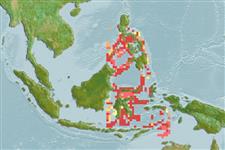Common names from other countries
Classification / Names / Names
Common names | Synonyms | Catalog of Fishes (gen., sp.) | ITIS | CoL | WoRMS
Environment: milieu / climate zone / depth range / distribution range
Ecology
Benthic; depth range 186 - 300 m (Ref. 4). Tropical; 16°N - 12°S, 117°E - 132°E (Ref. 4)
Western Central Pacific: Philippines.
Length at first maturity / Size / Weight / Age
Maturity: Lm ? range ? - ? cmCommon length : 14.9 cm BL male/unsexed; (Ref. 4)
It has lengths of 7 and 14.9 cm, total body length; 3 and 6.7 cm, carapace length (Ref. 4). Occurs at a depth from 186 to 300 m with firm substrate with mud (Ref. 4).
Life cycle and mating behavior
Maturity | Reproduction | Spawning | Eggs | Fecundity | Larvae
Members of the order Decapoda are mostly gonochoric. Mating behavior: Precopulatory courtship ritual is common (through olfactory and tactile cues); usually indirect sperm transfer.
Holthuis, L.B. 1991. (Ref. 4)
IUCN Red List Status (Ref. 130435)
CITES status (Ref. 108899)
Not Evaluated
Not Evaluated
Human uses
Fisheries: of no interest
| FishSource |
Tools
More information
Age/Size
Growth
Length-weight
Length-length
Morphology
Larvae
Abundance
Internet sources
Estimates based on models
Preferred temperature
(Ref.
115969): 12.7 - 16.5, mean 14.8 (based on 19 cells).
Price category
Unknown.
